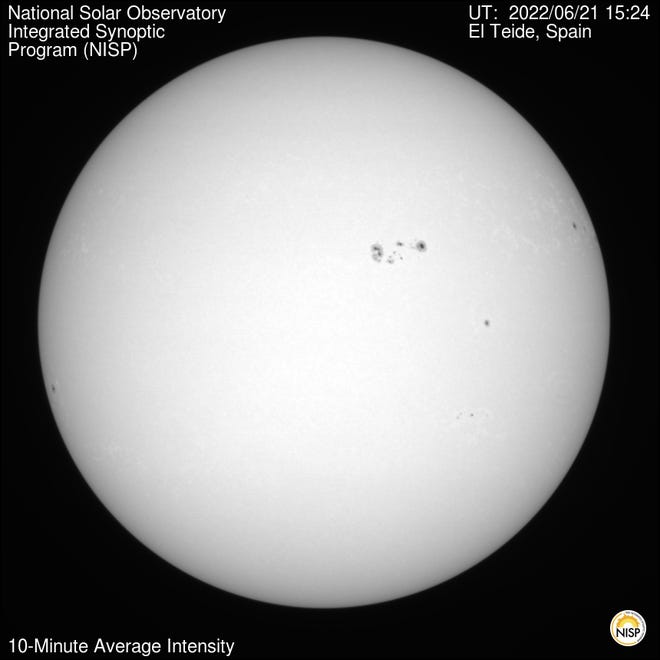- A sunspot, called AR3038, has been doubling in size each day for the past three days, a NASA scientist said. As sunspots grow, there’s a higher chance of solar flares.
- Solar flares can disrupt radio communications and power grids on Earth. But this sunspot is not particularly likely to cause intense flares, experts told USA TODAY.
- The flares also have little effect on most people on Earth, experts reassured, saying “there is no need to panic.”
A sunspot with the potential to cause solar flares captured the internet’s attention Tuesday as media reports warned of the sunspot pointing toward Earth.
But experts told USA TODAY the sunspot is far from unusual and eased concerns of how any potential solar flares would affect the Blue Planet.
Active Region 3038, or AR3038, has been growing over the last week, said Robert Steenburgh, acting lead of the National Oceanic and Atmospheric Administration’s Space Weather Forecast Office. The sunspot’s size and growth rate are fairly normal, he said.
“This is what sunspots do,” he said. “Over time, generally, they’ll grow. They go through stages and then they decay.”
GEOMAGNETIC STORM HEADED FOR EARTH:Aurora borealis could dazzle tonight across northern US
What are sun spots and solar flares?
Sunspots are areas on the surface of the sun that appear darker because they are cooler than other parts of the sun’s surface, according to NASA. Sunspots are cooler because they form where magnetic fields are strong and prevent the heat from within the sun from reaching its surface.
“I guess the easiest way to put it is that sunspots are regions of magnetic activity,” Steenburgh said.
GEOMAGNETIC STORM DAMAGE:Geomagnetic storm burns up to 40 of Elon Musk’s SpaceX satellites sent into orbit
Solar flares typically rise from sunspots and are “a sudden explosion of energy caused by tangling, crossing or reorganizing of magnetic field lines near sunspots,” NASA said.
“You can think of it like the twisting of rubber bands,” Steenburgh said. “If you have a couple of rubber bands twisting around on your finger, they eventually get twisted too much and they break. The difference with magnetic fields is that they reconnect. And when they reconnect, it’s in that process that a flare is generated.”
The larger and more complex a sunspot becomes, the higher the likelihood is for solar flares, Steenburgh said.
How quickly is AR3038 growing?
The sunspot has doubled in size each day for the past three days and is about 2.5 times the size of Earth, C. Alex Young, associate director for science in the Heliophysics Science Division at NASA’s Goddard Space Flight Center, said in an email.
Young added that the sunspot is already producing small solar flares but “does not have the complexity for the largest flares.” There is only a 30% chance the sunspot produces medium-sized flares and a 10% chance it will create large-sized flares, he said.
Still, W. Dean Pesnell, project scientist of the Solar Dynamics Observatory, said the sunspot is only a “modest-sized active region” that “has not grown abnormally rapidly and is still somewhat small in area.”
“AR 3038 is exactly the kind of active region we expect at this point in the solar cycle,” he said.
While the sunspot is one of the first “really big” ones of this solar cycle, a period of about 11 years that began in December 2019, Andrés Muñoz-Jaramillo, lead scientist at the SouthWest Research Institute in San Antonio, Texas, said it’s nothing for most people on Earth to worry about.
“I want to emphasize there is no need to panic,” he said. “They happen all the time, and we are prepared and doing everything we can to predict and mitigate their effects. For the majority of us, we don’t need to lose sleep over it.”
Types of solar flares, effects on Earth
Solar flares also have different levels, Muñoz-Jaramillo said. The smallest are A-class flares, followed by B, C, M and X at the highest strength. Within each letter class is a finer scale using numbers, with higher numbers denoting more intensity.
C flares are too weak to noticeably affect Earth, Muñoz-Jaramillo said, while more intense M flares may disrupt radio communication at Earth’s poles. X flares can disrupt satellites, communications systems and power grids and, at their worst, cause electricity shortages and power outages.
Lower-intensity solar flares are pretty common, while X flares are less so, Steenburgh said. In a single solar cycle, there are typically about 2,000 M1 flares, about 175 X1 flares and about eight X10 flares, he said. For the largest solar flares at X20 or above, there is less than one per cycle.
WHAT’S A SOLAR FLARE?:And how can a geomagnetic storm make auroras visible in the US?
The AR3038 sunspot has already caused C flares, Steenburgh said. And while there have been no M or X flares from this area yet, he said there is a potential for more intense flares in the next week or so.
“Chances for flares from this region continue to be good as the sunspot gets larger and more complex,” he said.
Steenburgh said Tuesday morning’s flare forecast included an 8% chance of C flares in the next 24 hours, a 25% chance of M flares, and a 10% chance of X flares, which he emphasized “is not really out of the ordinary.”
The Space Weather Prediction Center will monitor these probabilities and send out alerts as needed, though there were no solar flare warnings issued Tuesday morning, Steenburgh said.
Contact News Now Reporter Christine Fernando at cfernando@usatoday.com or follow her on Twitter at @christinetfern.


